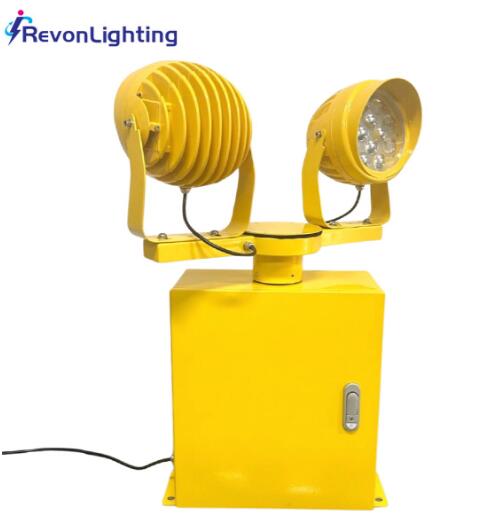Posted: 2025-07-03
In the complex world of aviation navigation, airport beacon for sale represents a critical component of airport infrastructure. These powerful rotating lights serve as visual landmarks, helping pilots identify airports from miles away during nighttime or low-visibility conditions. As air traffic continues to grow globally, the demand for reliable, high-quality airport beacons has never been higher.
This article examines the importance of airport beacons, their technical specifications, regulatory requirements, and what buyers should consider when evaluating an airport beacon for sale.
The Vital Role of Airport Beacons
Airport beacons provide the first visual confirmation of an airfield's location to approaching aircraft. Their distinctive flashing patterns help distinguish between different types of landing facilities:
White-Green for civilian airports

White-Yellow for water airports
White-White-Green for military airfields
Green-Yellow for heliports
These color-coded signals allow pilots to quickly verify they're approaching the correct facility, significantly enhancing flight safety during approach and landing phases.
| airport beacon for sale |
Key Components of Modern Airport Beacons
When evaluating an airport beacon for sale, buyers should understand the critical components:
High-Intensity LED Array - Modern beacons use LED technology for brighter output and lower power consumption
Precision Rotation Mechanism - Ensures consistent flash patterns at 12-30 RPM
Weather-Resistant Housing - Typically aluminum or polycarbonate construction
Optical System - Fresnel lenses or reflectors that maximize light projection
| airport beacons for sale |
Control System - Often includes photocell sensors for automatic dusk-to-dawn operation
Regulatory Compliance Standards
Airport beacons must meet strict aviation authority requirements:
FAA AC 150/5345-12E (U.S. standards for airport beacons)
ICAO Annex 14 (International Civil Aviation Organization standards)
EN 12430 (European norms for aeronautical ground lighting)
Certifications to look for when purchasing an airport beacon for sale include FAA, EASA, and ICAO compliance markings.
Types of Airport Beacons Available
The market offers several configurations to meet different operational needs:
1. Standard Rotating Beacons
Traditional design with rotating drum and xenon or halogen lamps
2. LED Airport Beacons
Modern solid-state versions offering:
50,000+ hour lifespan
Instant on/off capability
Reduced maintenance needs
3. Dual-Mode Beacons
Combine steady burning and flashing functions for enhanced visibility
4. Solar-Powered Options
Ideal for remote airfields without reliable grid power
Selection Criteria for Buyers
When considering an airport beacon for sale, evaluate these factors:
Visibility Range - Should be visible from at least 10-20 nautical miles
Flash Characteristics - Must match regulatory requirements for your airport class
Durability - Look for IP66 or higher weatherproof ratings
Power Requirements - Ensure compatibility with your electrical infrastructure
Maintenance Needs - LED models typically require less servicing
Mounting Options - Tower, roof, or ground mounting configurations
Installation Considerations
Proper installation is crucial for optimal performance:
Height Placement - Typically 20-50 feet above surrounding terrain
Obstruction Clearance - Must be free from light-blocking structures
Electrical Safety - Requires proper grounding and surge protection
Alignment - Must be visible from all approach angles
Emerging Technologies
The airport beacon market continues to evolve with:
Smart Monitoring Systems - Remote diagnostics and failure alerts
Adaptive Brightness Control - Automatic intensity adjustment for weather conditions
Hybrid Power Systems - Solar with battery backup options
Integrated Obstruction Lights - Combining beacon and tower lighting functions
Maintenance Best Practices
To ensure long-term reliability:
Clean lenses and housing quarterly
Check electrical connections annually
Verify rotation speed and flash characteristics
Replace backup batteries per manufacturer schedule
Keep vegetation cleared from light path
Global Market Trends
The airport beacon for sale market shows several key trends:
LED Dominance - Phasing out older xenon and halogen technologies
Smart Airport Integration - Beacons becoming part of IoT-enabled airport systems
Sustainability Focus - More solar and low-power options
Emerging Market Growth - Increasing demand in developing aviation markets
An airport beacon for sale represents more than just equipment - it's a vital safety component that contributes to the global aviation infrastructure. Modern LED technologies have transformed these navigation aids into reliable, low-maintenance systems that meet the demanding requirements of today's airports.
When selecting an airport beacon, aviation professionals must balance regulatory compliance, technical specifications, and operational needs. With proper selection, installation, and maintenance, these beacons will continue guiding pilots safely to their destinations for years to come.
As aviation technology advances, we can expect airport beacons to incorporate more smart features while maintaining their fundamental role as trusted visual navigation aids in the increasingly complex airspace environment.